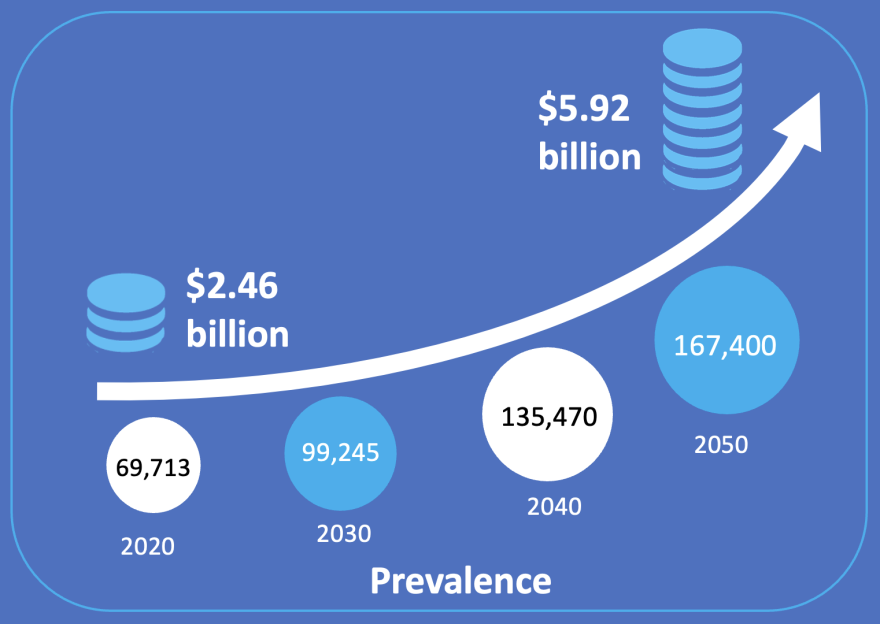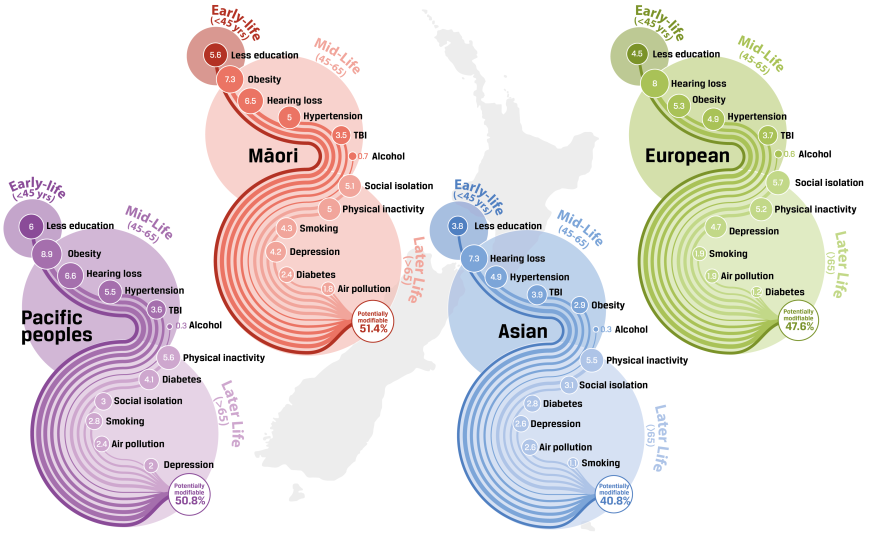Summary
As Aotearoa New Zealand's population ages, the number of people living with dementia is expected to double in the next 20 years – a major health and economic issue. Since age is the biggest risk factor for dementia and there’s currently no cure, there is a need to focus on reducing risks for dementia. The Lancet Commission recently reported that 45% of dementia cases worldwide could be prevented by tackling 14 key risk factors, such as smoking, obesity, high blood pressure, and lack of physical activity.
In NZ, the potential for prevention is even greater, especially for Māori and Pacific communities, who face higher rates of these risk factors. However individual lifestyle change is only a very incomplete answer. These risks often begin early in life, are linked to social disadvantage, and are more common in areas with higher poverty. A broader population-level, whole-of-government approach is required to address the health inequities associated with poverty and social disadvantage.
Dementia in Aotearoa NZ, disproportionately affects Māori and Pacific peoples
Age is the greatest risk factor for dementia. Based solely on population ageing, the number of people with dementia in Aotearoa NZ (NZ) is expected to double in the next 20 years (Figure 1). However, it will almost triple in the same period for Māori and Pacific peoples due to their younger age structure currently.1 Recent research shows the risk of dementia in Māori and Pacific peoples is 45%-80% higher compared to Pākeha in both young and late onset dementia due to the higher rates of risk factors in these ethnic groups. 2,3
Figure 1: Estimated future prevalence (total cases) and economic cost of dementia in NZ, 2020-2050. Adapted from Dementia Economic Impact Report 2020.1
Potentially modifiable risk factors for dementia
The 2024 Lancet Commission on dementia prevention, intervention, and care has identified 14 risk factors that, if completely eliminated, could prevent 45% of all dementias worldwide.4 These risk factors broadly fall into two groups. Firstly factors that result in damage to the brain: diabetes, high cholesterol, hypertension, smoking, obesity, air pollution, head injury, physical inactivity, high alcohol use, and untreated depression. Secondly, factors that reduce cognitive reserve, the brain’s ability to tolerate damage: low education, uncorrected hearing or vision loss, and social isolation. The potential for dementia prevention has been demonstrated to be higher in NZ, and even higher again in Māori and Pacific peoples compared to Europeans (Figure 1), due to the higher rates of risk factors compared to those used by the Lancet Commission.5
Figure 2: Dementia prevention potential in Aotearoa New Zealand. From Ma’u et al (2021).5
Social disadvantage and poverty are the main contributors to dementia risk
Our current NZ research demonstrates an association between social disadvantage and dementia. We have shown that the risk of developing dementia is 60% higher for people living in the most deprived areas of NZ compared to those in the least deprived areas.6 We have also shown that higher rates of risk factors for dementia are associated with increasing social disadvantage, regardless of ethnicity (Ma’u unpublished). Māori and Pacific peoples are overrepresented in the more disadvantaged areas of NZ society, with over 40% living in areas of high deprivation.7 These findings indicate that the higher risk and rates of dementia in Māori and Pacific peoples are not due to ethnicity per se but their overrepresentation in areas of high social disadvantage and poverty.
Dementia risk reduction requires a life course approach
While completely eliminating risk factors is unlikely in the near future, even modest reductions in rates of risk factors can significantly reduce dementia prevalence. Indeed, recent estimates indicate that reducing 12 of the 14 risk factors in NZ by just 10% could result in 3,000 fewer people with dementia.8 Most risk factors are present across the life course and it is their incremental and cumulative damage to the brain that eventually lead to dementia. This highlights the importance of interventions to promote brain health in early life and midlife, even when the immediate dementia risk is deemed to be low. Furthermore, many risk factors are associated with other chronic disease processes such as stroke and heart disease, so the impacts of any risk factor reduction initiatives will provide other health benefits.
Shifting from individual to population-level approaches to risk reduction
Many risk factors are conceptualised as something an individual can change but the realities are more complex and broader population-level approaches are required to appropriately address them. Many risk factors are associated with poverty and cluster in areas of greater social disadvantage. Effective policies and interventions will require a whole-of-government approach to address the health inequities associated with poverty and social disadvantage. Targeted legislative and public health measures reducing availability and marketing of alcohol, tobacco, and unhealthy food, in conjunction with optimised urban planning that promotes physical activity and social connection, can shift sociocultural norms and reduce risk at a population level.9
What this Briefing adds
- Lifestyle factors and potentially modifiable risk factors for dementia have increasingly become a focus for dementia prevention, with the recently released Lancet Commission estimating 45% of dementia cases worldwide are attributable to 14 risk factors
- NZ research indicates the dementia prevention potential is likely higher in NZ, and even higher again in Māori and Pacific peoples
- Many risk factors are associated poverty and cluster in areas of greater social disadvantage.
- Even modest reductions in risk factor prevalence can significantly reduce the number of people with dementia.
Implications for policy
- Effective policies and interventions will require a whole-of-government approach to address the health inequities associated with poverty and social disadvantage.
- A life course approach is required and highlights the importance of promoting brain health in early and midlife, even when the immediate dementia risk is deemed to be low.
- Many risk factors cannot be addressed in isolation and lifestyle interventions are complex so we need to shift from a focus on the individual to broader population-level approaches.
- Targeted legislative and public health policies can shift sociocultural norms and reduce risk at a population level.
Authors details
Dr ‘Etuini Ma’u, Department of Psychological Medicine, University of Auckland
Associate Professor Sarah Cullum, Department of Psychological Medicine, University of Auckland
Associate Professor Gary Cheung, Department of Psychological Medicine, University of Auckland



